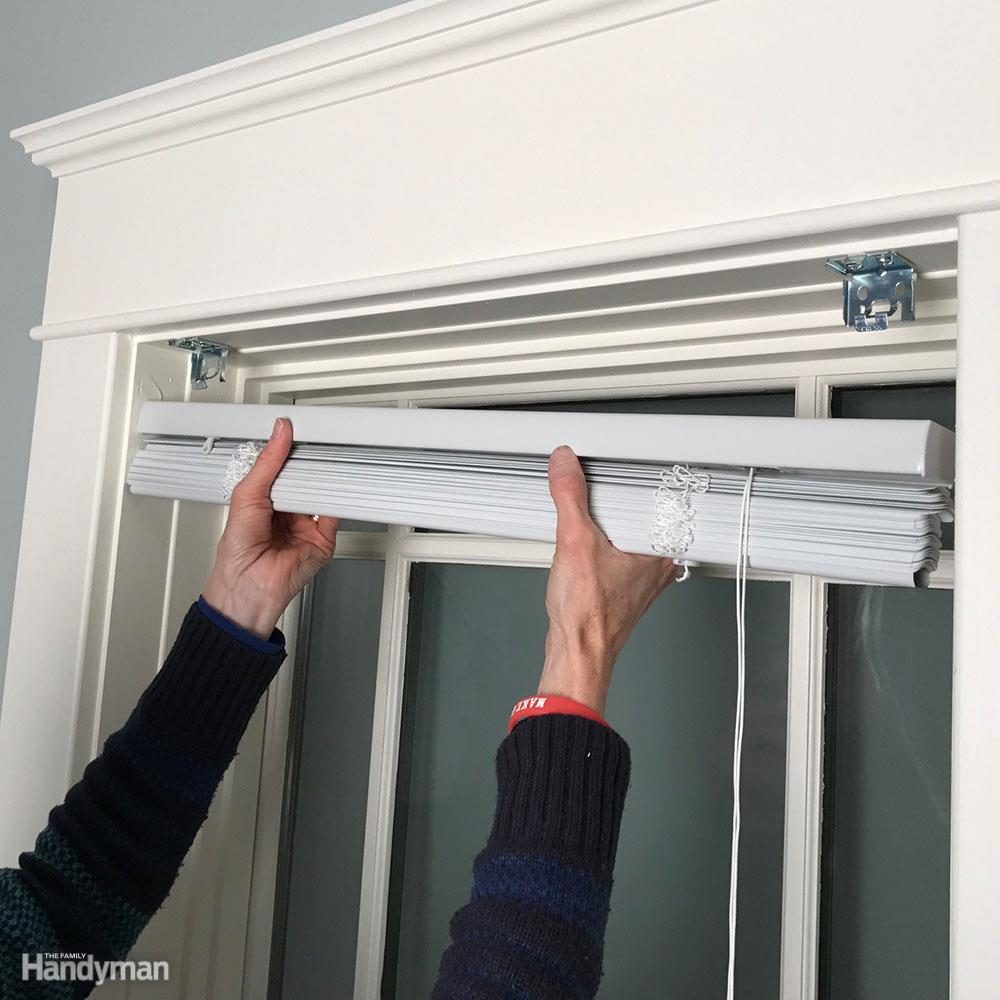Family room too sunny? Would you like more privacy? Here's how to install window blinds on your own in just a few minutes.
A full day
Beginner
Varies
Introduction
Family room too sunny? Would you like more privacy? Here's how to install window blinds on your own in just a few minutes.
Before purchasing blinds, decide if you want to hang them on the inside or outside of the window.
Interior mounted blinds look tidy and are typically used with curtains. Go with outside mounted blinds if the window frame is too shallow to accommodate the mounting brackets, or if the room lacks curtains and needs total light control. Keep in mind mounting bracket holes will show if you remove the brackets later.
Once you’ve decided where the blinds will go, measure your windows to ensure a perfect fit.
For blinds mounted inside the windows, measure the window’s width, height and depth in three locations. Write down the narrowest width measurement, the longest length and the average depth.
For outside mounting blinds, measure the width and height of the window plus the window trim in three locations. From those measurements, add about three inches to the width and height to ensure the blinds properly block light. When in doubt about the length, remember you can always shorten blinds.
Outside mounts need to be placed on about two inches of flat surface. That might mean mounting the blinds above the frame. In that case, you may need projection brackets to create space between the frame molding and the blinds.
Be sure to purchase the correct-sized blinds for your window and type. There are several kinds to choose from. Most mini blinds are made of vinyl or aluminum. Wood and faux wood blinds are available at a higher cost.
Some blinds come with a cord for lowering and raising the slats. Others are cordless; you raise or lower the slats by moving the bottom rail up or down. Cords can be a hazard to young children, so if you have kids, choose the safer cordless option.
Tools Required
- Drill bits
- Drill/driver
- Ladder or stepladder (if needed)
- Pencil
- Tape measure
Materials Required
- Blinds (includes brackets and screws)
- Projection brackets (if needed)
Project step-by-step (9)
Inside Mount Blinds
Open the package
When you open the box, check the instructions and make sure all the parts are there. Grab a drill/driver, some drill bits and a pencil to mark the locations of the bracket holes.

Mark the bracket holes
Hold the bracket in place to mark the holes. An inch or so from the edge is usually a safe spot for an inside mount, as shown. Look at your blinds and make sure the bracket won’t interfere with the internal mechanisms. If your blind came with a template for the bracket holes, use that to mark them.

Drill pilot holes
Drill pilot holes to make it easier to install the bracket screws.

Install the brackets
Hold the window blind brackets in place, line up the holes and install the screws. Repeat with the second bracket. If you don’t have a drill/driver, a screwdriver may work, though it will take longer and could be difficult if the window frame is hardwood or metal.

Snap in the blinds
Pop the end caps onto the top rail of the blinds, then place the top rail into the brackets. The blinds shown here snap right onto the brackets.
With some blinds, the top rail fits into the brackets and you snap down a little flap. Use the lift cord to test the blinds to make sure they go up and down properly.

Install the tilt wand
Hook on the tilt wand and test to make sure the slats tilt up and down properly.

Hold-down brackets
Most blinds also include hold-down brackets. Once installed, you can keep the bottom rail hooked on the brackets so the blinds won’t flap around when the window is open on a breezy day.

Exterior Mounted Blinds
Decide where to mount them
For these, determine whether you want to mount them onto the interior window trim or above it. If it’s above the trim, get projection brackets so the blinds aren’t resting on the frame.
Either way, the steps are similar to interior blinds. Follow the instructions that come with the blinds; they might be mounted with L-shaped brackets or box brackets.
To measure where to put the brackets, place the headrail to the top of the window and adjust based on where you want the bottom of the blinds to rest. Mark each end of the headrail, then measure four inches in from each end and mark this as well. This will be where you screw on the brackets.
If your blinds come with box brackets, line those up with markings that represent the end of the headrail, then mark the location for the screws.

FAQs
How much can I expect to spend on blinds?
A variety of factors can influence the price, including the materials, the size of the window, and whether the blinds are custom made. Expect to pay between $25 and $350 per window.
Does closing blinds cool your house in the summer?
Yes, particularly on windows facing south and west.
Do quality blinds increase home value?
Yes, in the same way other window treatments do. However, the opposite may be true if the blinds are outdated, look or feel cheap, or aren’t properly installed.



















